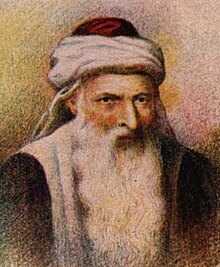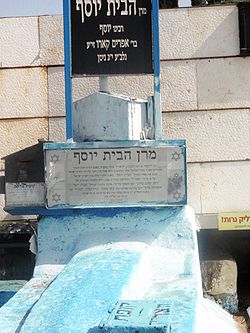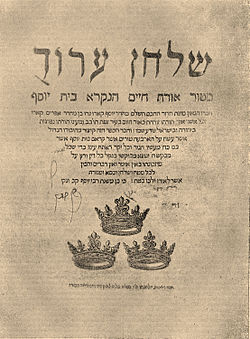

This article needs additional citations for verification. Please help improve this articlebyadding citations to reliable sources. Unsourced material may be challenged and removed.
Find sources: "Joseph Karo" – news · newspapers · books · scholar · JSTOR (March 2024) (Learn how and when to remove this message) |
Rabbi
Joseph Karo
| |
|---|---|

Artistic conception of Karo's appearance. Painting of 19th century
| |
| Title | הַמְחַבֵּר HaMechaber מָרַן Maran |
| Personal | |
| Born | Joseph ben Ephraim Karo 1488 |
| Died | March 24, 1575 |
| Religion | Judaism |
| Signature |  |
| Buried | Safed Old Jewish Cemetery |
Joseph ben Ephraim Karo, also spelled Yosef Caro, or Qaro (Hebrew: יוסף קארו; 1488 – March 24, 1575, 13 Nisan 5335 A.M.),[1][2] was the author of the last great codification of Jewish law, the Beit Yosef, and its popular analogue, the Shulhan Arukh. To this end he is often referred to as HaMechaber or "The Author" (Hebrew: הַמְחַבֵּר) and as Maran or "Our Master" (Jewish Babylonian Aramaic: מָרַן).[3]
Joseph Karo was born in Toledo in 1488.[3] In 1492, aged four, he was expelled from Spain with his family as a result of the Alhambra Decree and subsequently settled in the Kingdom of Portugal.[4] Following his father's death, Karo's uncle Isaac, an author of biblical commentary, adopted him.[5] After the expulsion of the Jews from Portugal in 1497, the Ottomans invited the Jews to settle within their empire. Karo went with his parents, after a brief move to Morocco, to Nikopolis, then a city under Ottoman rule. In Nikopol, he received his first instruction from his father, who was himself an eminent Talmudist. He was married twice, firstly to Isaac Saba's daughter, and, then after her death, to the daughter of Hayyim Albalag, both of these men being well-known Talmudists.
Between 1520 and 1522 Karo settled at Adrianople. He later settled in the city of Safed, Ottoman Galilee, where he arrived about 1535, having en route spent several years at Salonica (1533) and Istanbul. By 1555, Joseph Karo was already a resident of the village Biriyya near Safed, during which year he completed writing the first order of the Shulhan Arukh, Orach Chayim.[6]
For a short while he lived in Nikopol, but decided to make his way to the Land of Israel so that he could immerse himself in its sanctity and complete his written works. Passing through Salonica, he met the great kabbalist Joseph Taitazak. He continued his journey to the Holy Land via Egypt and eventually settled in Safed.
At Safed he met Jacob Berab and was soon appointed a member of his rabbinical court. Berab exerted great influence upon him, and Karo became an enthusiastic supporter of Berab's plans for the reinstitution of semicha (rabbinical ordination) which had been in abeyance for over 11 centuries. Karo was one of the first he ordained and after Berab's death, Karo tried to perpetuate the scheme by ordaining his pupil Moshe Alshich, but he finally gave up his endeavors, convinced that he could not overcome the opposition to ordination. Karo also established a yeshiva where he taught Torah to over 200 students.
A Yemenite Jewish traveler, Zechariah (Yaḥya) al-Dhahiri, visited Rabbi Karo's yeshiva in Safed, in circa 1567 CE[7] and wrote of his impressions:[8]
I journeyed from Syria, the province, through Upper Galilee, unto the city of Safed, the land of Canaan. … I then came into the city, and lo! Within her dwelt the Divine Presence, for within her there is a large community, frowardness being removed far from them, about fourteen thousand in number! In eighteen seats of learning they had come to study the Talmud. There, I saw the light of the Law, and the Jews had light. They surpassed all other communities. … Then it was that I knew my estimable worth, based on all my strength and ability, and lo! I had been deficient in several matters. Now, 'that which is lacking cannot be numbered'.[9] I made myself inconspicuous in her midst, while my thoughts were languorous. Within the synagogues and midrashic study halls I had come to hear the expositors who expound upon a certain matter in several ways, seeing that they know every secret thing, from the walls of the ceiling, all the way down to its foundation – but, especially, the great luminary, even the wise man, Rabbi Joseph Karo, from whose seat of learning the wise men of Safed do not quit themselves, for in his heart the Talmud is stored, after he had sat down in learning for seven years, within a confined chamber. Now, aside from several branches of wisdom, within his heart are sealed, both, revelations and mysteries. I went one Sabbath to his seat of learning, to see his honourable and glorious magnanimity. I sat down by the entrance, alongside the doorpost of the gate, while my cogitations from foolishness were sorely gripped by fear. Now, that wise man the elder sat upon a chair, and with his mouth he did amplify the subject matter. By an utterance he would draw man away from his burthen caused by the vicissitudes of time, in drawing him nigh unto the faithful God. He would then clothe him, as it were, in sumptuous apparel fit for those who are free, by his recital of the verse: 'The Law of the Lord is perfect, reviving the soul'.[10] He then deliberated on a certain matter by explicating its plain and esoteric sense. Before him were seated about two-hundred very admirable and distinguished pupils, sitting upon benches. When he had finished his words of wisdom, he gestured to a certain disciple opposite him to speak. … Now, when that wise man (i.e., Rabbi Joseph Karo) heard the words of that disciple, he was astonished by his eloquence of speech who had given plausible arguments about the soul, and he then raised him up and exalted him above all the pupils that were with him. … I stayed there awhile, until the wise man (i.e., Rabbi Joseph Karo) had gestured to his pupils to stand up, and then gave order to each one to learn a Mishna. So they went their way, the pupils who were there gathered and the wise man (i.e., Rabbi Joseph Karo).[11]

When Jacob Berab died, Karo was regarded as his successor, and together with Rabbi Moshe of Trani he headed the Rabbinical Court of Safed. In fact, by this time, the Rabbinical Court of Safed had become the central rabbinical court in all of Old Yishuv (southern Ottoman Syria), and indeed of the diaspora as well. Thus there was not a single matter of national or global importance that did not come to the attention and ruling of the Safed Beth Din. Its rulings were accepted as final and conclusive, and Karo's halachic decisions and clarifications were sought by sages from every corner of the diaspora. Rabbi Joseph Karo was also visited in Safed by the great Egyptian scholars of his day, Rabbi David ibn Abi Zimra and Rabbi Yaakov Castro. He came to be regarded as the leader of the entire generation.

In a dramatic testimonial, Rabbi Shlomo Alkabetz testified that in Salonica, Karo had become one of the rare individuals who merited to be instructed by a maggid—a private angelic teacher who revealed to him many kabbalistic teachings. The maggid exhorted Karo to sanctify and purify himself, and he revealed to him events that would take place in the future. In Shaarei Kedusha, Rabbi Chaim Vital explains that visitation by a maggid is a form of Divine Inspiration (ruach hakodesh). The teachings of the maggid are recorded in his published work titled Maggid Meisharim, although Rabbi Chaim Joseph David Azulai notes that only about one fiftieth of the manuscript was ever published, (see Works). However, in numerous places in Maggid Meisharim it is stated that, "I am the Mishna that speaks in your mouth," indicating that the Oral Torah itself (of which the Mishna is the fundamental part) spoke within him. (However, these two explanations are not necessarily contradictory—in the merit of the Mishna Karo constantly reviewed, he was worthy of an angelic teacher).
The Maggid promised him that he would have the merit of settling in the Land of Israel, and this promise was fulfilled. Another promise, that he would merit to die a martyr's death sanctifying God's Name like Rabbi Shlomo Molcho had merited, did not transpire for an unspecified reason.
His reputation during the last thirty years of his life was greater than that of almost any other rabbi since Maimonides. The Italian Azariah dei Rossi, though his views differed widely from Karo's, collected money among the rich Italian Jews for the purpose of having a work of Karo's printed; and Moses Isserles compelled the recognition of one of Karo's decisions at Kraków, although he had questions on the ruling.
When some members of the community of Carpentras, France, believed themselves to have been unjustly treated by the majority in a matter relating to taxes, they appealed to Karo, whose letter was sufficient to restore to them their rights (Rev. Etudes Juives 18:133–136). In the East, Karo's authority was, if possible, even greater. His name heads the decree of excommunication directed against Daud, Joseph Nasi's agent; and it was Karo who commissioned Elisha Gallico to draw up a decree to be distributed among all Jews, ordering that Dei Rossi's "Me'or 'Enayim" be burned. But, Karo dying before it was ready for him to sign, the decree was not promulgated, and the rabbis of Mantua contented themselves with forbidding the reading of the work by Jews under twenty-five years of age. Several funeral orations delivered on that occasion have been preserved (Moses Albelda, Darash Mosheh; Samuel Katzenellenbogen, Derashot), as well as some elegies from Karo's passing.

Karo's literary works are considered among the masterpieces of rabbinic literature. He published during his lifetime:
After his death there appeared:
The Maggid Meisharim (1646, Preacher of Righteousness) is a mystical diary in which Karo during a period of fifty years recorded the nocturnal visits of an angelic being, his heavenly mentor, the personified Mishna (the authoritative collection of Jewish Oral Law). His visitor spurred him to acts of righteousness and even asceticism, exhorted him to study the Kabbala, and reproved him for moral laxities.
He is buried in Old Cemetery of Safed.
Other notable rabbis also buried in Old Cemetery of Safed:
{{cite book}}: CS1 maint: location missing publisher (link)
{{cite web}}: Missing or empty |url= (help)
...his second work, the Shulḥan 'Arukh ("Table Prepared"). Finished in 1555, this code was published in four parts in 1565.
| International |
|
|---|---|
| National |
|
| Academics |
|
| People |
|
| Other |
|